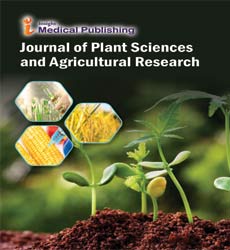Plant Pheromones and Microbial Interactions in the Rhizosphere
Alexander Smith*
Department of Environmental Sciences, Curtin University, Perth, Australia
- *Corresponding Author:
- Alexander Smith
Department of Environmental Sciences, Curtin University, Perth,
Australia,
E-mail: smith_a@cune.au
Received date: August 26, 2024, Manuscript No. IPJPSAR-24-19142; Editor assigned date: August 28, 2024, PreQC No. IPJPSAR-24-19142 (PQ); Reviewed date: September 11, 2024, QC No. IPJPSAR-24-19142; Revised date: September 18, 2024, Manuscript No. IPJPSAR-24-19142 (R); Published date: September 25, 2024, DOI: 10.36648/ipjpsar.8.3.152
Citation: Smith A (2024) Plant Pheromones and Microbial Interactions in the Rhizosphere. J Plant Sci Agri Res Vol.8 No.3: 152.
Description
Plant pheromones are chemical compounds released by plants to communicate with other organisms, including neighboring plants, insects and microorganisms. These Volatile Organic Compounds (VOCs) play a vital role in mediating various ecological interactions and physiological processes within plant communities. While pheromones are often associated with animals, particularly insects, research has revealed that plants also use chemical signaling to convey information and coordinate their responses to environmental cues.
One of the most well-known functions of plant pheromones is in defense against herbivores and pathogens. When attacked by herbivorous insects or pathogens, plants can emit volatile compounds that serve as warning signals to neighboring plants, alerting them to the imminent threat. This phenomenon, known as plant-plant communication or allelopathy, enables neighboring plants to preemptively activate their own defense mechanisms, such as the production of toxic secondary metabolites or the recruitment of natural enemies of herbivores.
In addition to defense, plant pheromones also play a role in attracting pollinators and beneficial organisms that aid in plant reproduction and health. Floral scents, for example, are composed of a complex mixture of volatile compounds emitted by flowers to attract pollinators such as bees, butterflies and birds. These pheromones serve as olfactory cues that guide pollinators to flowers, facilitating the transfer of pollen and ensuring successful fertilization and seed production.
Sustainable agriculture
Moreover, plant pheromones can modulate the behavior and interactions of soil microbes, including beneficial symbionts such as mycorrhizal fungi and rhizobia, as well as pathogenic microbes such as soil-borne pathogens. By releasing specific chemical signals into the rhizosphere, the region of soil surrounding plant roots, plants can influence the composition and activity of microbial communities, promoting beneficial associations and suppressing harmful pathogens.
The biosynthesis and emission of plant pheromones are tightly regulated by various environmental factors and internal signaling pathways. For example, plants can perceive external stimuli such as light, temperature, humidity and herbivore damage and adjust their pheromone production accordingly. In addition, plant hormones such as Jasmonic Acid (JA), Salicylic Acid (SA) and Ethylene (ET) play key roles in regulating the expression of genes involved in pheromone biosynthesis and emission in response to biotic and abiotic stresses.
Advances in analytical techniques, such as Gas Chromatography-Mass Spectrometry (GC-MS) and Nuclear Magnetic Resonance (NMR) spectroscopy, have enabled scientists to identify and characterize the chemical composition of plant pheromones with high precision. These tools have revealed the remarkable diversity of plant pheromones across different species and provided insights into their ecological functions and evolutionary origins.
Furthermore, understanding the role of plant pheromones in mediating ecological interactions has practical implications for agriculture, ecology and conservation. By manipulating plant pheromone production or composition, researchers aim to develop novel strategies for pest management, crop protection and restoration of degraded ecosystems. For example, pheromone-based approaches such as trap cropping, where plants are strategically planted to attract and trap herbivores away from main crops, offer sustainable alternatives to chemical pesticides and contribute to Integrated Pest Management (IPM) strategies.
Conclusion
Plant pheromones represent a fascinating and multifaceted aspect of chemical ecology, playing diverse roles in mediating ecological interactions and shaping plant communities. From defense against herbivores and pathogens to attraction of pollinators and beneficial organisms, plant pheromones serve as key mediators of communication and cooperation within ecosystems. As our understanding of plant pheromone signaling continues to grow, so too will the opportunities for harnessing this knowledge to address pressing challenges in agriculture, ecology and environmental sustainability.
Open Access Journals
- Aquaculture & Veterinary Science
- Chemistry & Chemical Sciences
- Clinical Sciences
- Engineering
- General Science
- Genetics & Molecular Biology
- Health Care & Nursing
- Immunology & Microbiology
- Materials Science
- Mathematics & Physics
- Medical Sciences
- Neurology & Psychiatry
- Oncology & Cancer Science
- Pharmaceutical Sciences
